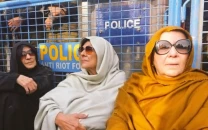Khairpur and Dadu flood survivors: 3 toilets for 300 people
There are children of all ages at a relief camp set up in a government high school in Dadu.

Khairpur and Dadu flood survivors: 3 toilets for 300 people
Of all the people affected, the floods have hit the children hardest. There are children of all ages at a relief camp set up in a government high school in Dadu. The youngest was born here and is seven days old.
It takes a while to get used to the miasma and flies that suffocate the camp.
In one of the rooms, a woman lies motionless, staring into space. “She lost her senses when she saw her children drowning,” says Panjatan’s mother standing next to her charpoy. The fishermen saved her children but she hasn’t recovered from the trauma, she adds.
Life at the camp is not easy. There are 373 people living in the school and between four to five families in each classroom. It is worse for the women. “There are more than 300 people here and just three toilets,” they say. The people who were able to bring their charpoys have something to sleep on. Others sleep on the ground.
At a boy’s primary school in Khairpur, which now houses 282 people, including 149 children, it is even worse. Human faeces comes underfoot. You have to hold your breath to pass through. Nonetheless, the children are barefoot, naked or wear tattered clothes. Their families fled with the clothes on their backs. People complain that government relief is not enough. “The government brought us food and the next day we all got sick. And there was no water either because the motor was not working,” a woman said. “I want to go back as soon as the water recedes,” said another woman who was cooking over burnt wood.
Although all has been lost, Sindhi hospitality survives. “You must come and have tea at our house,” a little girl Shakeela insisted. Her ‘house’ is one of the tents set up by the government at Faridabad bund.
In the searing sun, all they have for shelter are the tents by the bund. The displaced people claim that there are 3,000 of them living in the area. “There are around 200 villages in the water and many people are still in their homes,” said one landlord. It is difficult to imagine homes much less villages; everything is submerged. All you can see is water.
Fortunately, disease has not yet spread here but there are no preparations to tackle it. “There are only medicines for fever and skin problems here. If anything else happens, there is nothing that can be done,” said a villager.
“Sometimes we get food and sometimes we do not. People come here and give speeches about giving us boats and food and nothing ever happens,” another villager added.
However, some people defend the government. “The government does provide food twice a day,” said resident Ali Gohar. “They warned us many times but we did not move. We just didn’t imagine that so much water could come,” he added.
Government assistance
DCO Khairpur Abbas Balouch says they had not thought that the number of people displaced would be so high. “I thought the number of people would be in the thousands, but people from other districts have come here too and now there are hundreds of thousands of people,” he said.
Balouch’s phone rings every few minutes. With every call, he discusses the rescue and relief operation. The primary concern remains food for the displaced. “There is an influx of people every day,” he says, adding that the two million rupees they spend each day is not sustainable. “We haven’t received enough funds from the federal government. We are using the funds we have for emergencies,” said another official at the Flood Emergency Cell.
The flood emergency cell in Khairpur is consistently updated with details of relief camps in the area and the people displaced. There is also complete documentation of the relief goods sent, which is shared by local NGOs and other relevant people. However, the rift between different government segments remains. Federal lawmaker Nawab Wassan claimed that the district government has misused all the funds. “There is no cooperation from the district government. I help people with my personal funds; God can see that,” he said.
Meanwhile, DCO Dadu Iqbal Memon claimed that the irrigation officials had given them wrong information about the intensity of the floods. “But we started evacuating people from July 31,” he said.
“One of the reasons people were not willing to evacuate was that many people who live in the kachcha areas are criminals. They feared that if they step out, they would be arrested,” he added.
Memon also said there was not enough money from the government. “They have given us Rs3 million whereas we have spent Rs25 million on food alone,” he said.
A Red Cross official, Dr Amjad Baloch, said the district government was working but ministers were wasting time and resources. A minister goes to a particular bund and 25 to 60 people follow. In the end, no one is responsible for any one thing, he said. “They need to share the work, not just travel together,” he added.
Some people remain hopeful that the crisis of the displaced people may end soon. “The way the government is working, this process will not last too long,” said Saleem Lashari from the Dadu office of NGO Indus Resource Centre. “There is a big difference in how things are now, as opposed to how they were in the floods of 2007. At that time there was no government response to be seen.”
Education
As schools and colleges across the country have been turned to relief camps, one of the losses yet unaccounted for is education. Headmaster Arshad Ali said his school building has been badly damaged since the flood survivors took over. “The school is ruined. People have broken furniture to make fire to cook and there are wall chalkings everywhere,” he said.
There is much uncertainty on how long the situation is going to stay this way. Ali said there is nothing they can do until the water recedes. “After that we’ll have to repair the school. It’s hard to tell when it will open but it doesn’t seem like it can happen until August ends,” he said. The students come here at normal school timings and help with the relief operation.
Sukkur EDO Education Jai Ram Das said all government schools and colleges in Sukkur city are being used for relief camps. “Only God knows when schools and colleges will start again. Unicef is trying to make alternate arrangements for classes but the number of students in the government schools is too high. You cannot teach 1,500 students in a tent,” he said. Despite the fears that the floods have brought and uncertainty about what lies ahead, spirits remain high wherever possible.
Near the bund of the Dadu-Moro bridge, an occasional ice cream jingle is heard as people stand by to see the water. Children are seen swinging by the embankment and families take a boat ride in what was once solid ground. People by the Indus seem to celebrate what they can.
Published in The Express Tribune, August 16th, 2010.



















COMMENTS
Comments are moderated and generally will be posted if they are on-topic and not abusive.
For more information, please see our Comments FAQ